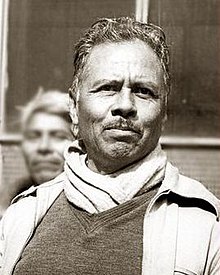Rubén Jaramillo

Rubén Jaramillo Méndez (1900 – May 23, 1962) was a
Mexican Revolution
Jaramillo was born in
During the 1920s and 1930s, Jaramillo advocated on behalf of ejidos, grants of communally owned land by the federal government to farmers. He supported the 1934 presidential campaign of Lázaro Cárdenas, who created a cooperative sugar mill in Zacatepec in 1938 at Jaramillo's urging. Jaramillo was elected by the workers to help run the mill, but his advocacy on behalf of the workers led to frequent clashes with administrators appointed by the government.[1]
Jaramillista movement
When workers at the Zacatepec sugar mill went on strike in 1943, Jaramillo persuaded the campesinos to stop producing
For the next nine years, Jaramillo fought for land reform within the electoral system. He founded the Agrarian Labor Party of Morelos (Partido Agrario Obrero Morelense, or PAOM), which quickly had 15,000 members. Jaramillo ran as its candidate for governor of Morelos in 1946 and 1952.[5] Jaramillo lost both times, although he and his followers disputed the official election results.[6][7]
In 1953, Jaramillo again led an armed revolt against the government. For the next five years he and the Jaramillistas eluded the army. The army brought cavalry and artillery against the rebels, and it was assisted by the air force. Finally, amnesty was negotiated with President Adolfo López Mateos in 1958.[8][9]
López Mateos had promised Jaramillo he would support the campesinos of Morelos, but Jaramillo was soon disappointed.[9] When cattle ranchers began to take the land previously granted as ejidos, the federal government did nothing. Jaramillo led thousands of farmers in resistance.[10] Jaramillo attempted to negotiate with the government on their behalf. While the government delayed, the campesinos occupied the land illegally. The government asked Jaramillo to help remove the squatters while the legal process continued; most of the farmers agreed. When the federal government ultimately turned down the farmers' request for assistance, Jaramillo appealed to López Mateos but the president refused to meet with him. In 1961, the campesinos again occupied the land. This time, the army removed them.[11]
Death
On May 23, 1962, Jaramillo's home was raided by a group of Federal Judicial Police and soldiers. He, his wife Epifanía, and his three stepsons were taken to Xochicalco, Morelos, where they were killed.[12] The only surviving member of the family was a stepdaughter, who had fled to ask the town's mayor for help.[13]
A few days after the murders, Carlos Fuentes went to Xochicalco and wrote an article that was published in Siempre!, a popular magazine:[14]
They pushed him down. Jaramillo could not hold himself back, he was a lion of the field, that man.... He threw himself at the party of murderers; he was defending his wife and his stepchildren, they brought him down with their rifle butts, they knocked out an eye. Epifanía flung herself on the murderers; they tore her rebozo, they tore her dress, they threw her on the stones. [One son] cursed at them; they opened fire and he doubled over and fell beside his mother, on the stones. While he was still alive, they opened his mouth, picked up fistfuls of earth, pulled open his mouth and laughing filled it with earth. After that it went fast; [the other sons] fell riddled with bullets; the submachine guns spat on the five fallen bodies. The squad waited for them to stop breathing. But they went on living. They put their pistols to the foreheads of the woman and the four men. They fired the finishing shots.[15]
Jaramillo's death was news around the world.[16] He became a folk hero. Villages and schools were named after him.[17] The article by Fuentes was widely reprinted. U.S. singer-songwriter Phil Ochs wrote a song about Jaramillo.[18] Nobody was charged with the killings.[1]
See also
References
- ^ ISBN 0-8223-3042-3.
- ISBN 1-84277-124-8.
- ISBN 1-85984-719-6.
- ISBN 9781842771259.
- ISBN 9781842771259.
- ISBN 0-521-81679-3.
- ISBN 9781842771259.
- ISBN 0-275-97330-1.
- ^ ISBN 9781842771259.
- ISBN 9781859843727.
- ISBN 9781842771259.
- . Retrieved March 5, 2010.
- ISBN 9781842771259.
- ISBN 0-393-05926-X.
- ISBN 0-06-016325-9.
- ISBN 9780275973308.
- ^ "A 41 años de la fundación de la Rubén Jaramillo – Conurbados Morelos". conurbados.com. April 11, 2014. Retrieved December 21, 2018.
- ISBN 9780393059267.
Further reading
- ISBN 0-520-21183-9.
- Jaramillo, Rubén; Manjarrez, Froylán (1967). Autobiografía (in Spanish). Mexico City: Editorial Nuestro Tiempo. OCLC 1301556.
- Macín, Raúl (1970). Jaramillo: Un Profeta Olvidado (in Spanish). Montevideo: Tierra Nueva. OCLC 1684221.
- McCormick, Gladys I. (2002). Heroes, Myths, and Citizens in Mexico: The Case of Rubén Jaramillo (Thesis). University of Wisconsin–Madison.
- Padilla, Tanalís (2008). Rural Resistance in the Land of Zapata: The Jaramillista Movement and the Myth of the Pax Priísta, 1940–1962. Durham, N.C.: Duke University Press. ISBN 978-0-8223-4337-0.
